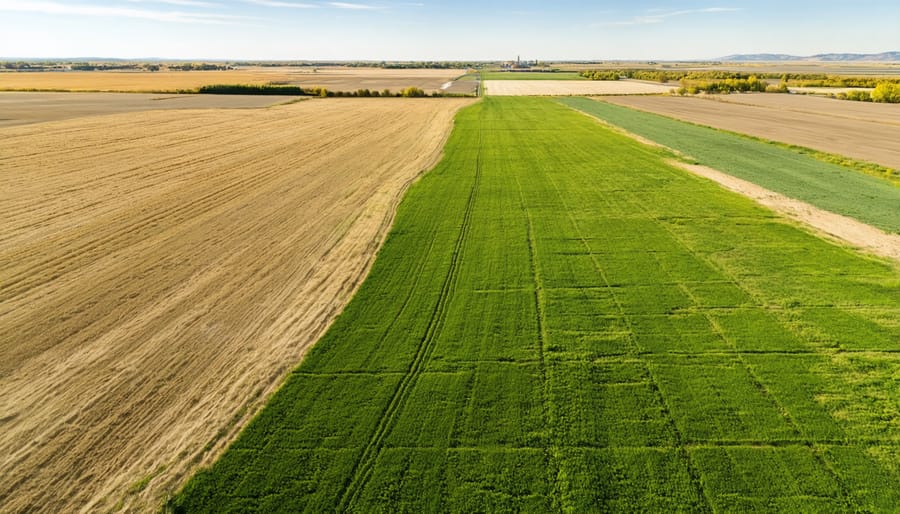The Nutrient Cycling Process

Key Players: Microbes, Fungi, and Plants
Soil organisms, including microbes, fungi, and plants, play crucial roles in nutrient cycling within the soil. Bacteria and other microorganisms break down organic matter, releasing essential nutrients like nitrogen, phosphorus, and potassium for plants to absorb. Fungi, such as mycorrhizae, form symbiotic relationships with plant roots, enhancing nutrient uptake and improving soil structure. These beneficial fungi extend the reach of plant roots and help them access water and nutrients that would otherwise be unavailable.
Plants also contribute to nutrient cycling by drawing nutrients from the soil and incorporating them into their tissues. When plants die or shed leaves, they return these nutrients to the soil, where decomposers break them down for future use. Cover crops and crop rotations, common practices among Canadian farmers, help maintain soil health and fertility by adding organic matter and nitrogen to the soil. By fostering a diverse and thriving community of soil organisms, farmers in the Alberta region can optimize nutrient cycling, improve soil structure, and promote sustainable agriculture practices that benefit both their crops and the environment.
The Nutrient Recycling Loop
The nutrient recycling loop is a dynamic process that involves the continuous movement of essential nutrients between organisms, soil, and plants. It begins with plants absorbing nutrients from the soil through their roots. As plants grow and develop, they incorporate these nutrients into their tissues. When plants die or shed leaves, the organic matter falls to the ground and becomes part of the soil. Microorganisms, such as bacteria and fungi, break down this organic matter, releasing the nutrients back into the soil in forms that plants can use. This process, known as decomposition, is crucial to how nutrient cycling works. In addition to decomposition, other processes like nitrogen fixation and mineralization also contribute to the nutrient recycling loop. Nitrogen-fixing bacteria convert atmospheric nitrogen into forms that plants can use, while mineralization involves the conversion of organic nutrients into inorganic forms. As plants take up these recycled nutrients, the loop continues, ensuring a sustainable supply of essential elements for plant growth and soil health. By understanding and supporting this natural process, farmers can optimize their soil’s fertility and productivity.
5 Practices to Boost Nutrient Cycling

Embrace Cover Crops
Cover crops are a powerful tool for capturing and recycling nutrients in your soil. By planting crops like legumes, grasses, and brassicas between cash crop seasons, you can prevent nutrient leaching and erosion while adding organic matter to the soil. As these cover crops grow, they absorb excess nutrients from the soil, storing them in their biomass. When the cover crops are terminated and incorporated into the soil, those nutrients are released back into the soil for the next cash crop to use. This cyclical process helps maintain soil fertility and reduces the need for external inputs. To maximize the benefits, embrace cover crops by selecting species that fit your specific soil needs and climate, and be sure to manage them properly for optimal growth and nutrient capture. By integrating cover crops into your rotation, you’ll be well on your way to building healthier, more productive soils.
Rotate for Soil Health
Implementing diverse crop rotations is a key strategy for enhancing nutrient cycling in your soil. By alternating between different crop types, such as legumes, cereals, and oilseeds, you can optimize nutrient uptake and minimize depletion. Legumes, like alfalfa and peas, fix atmospheric nitrogen in the soil, reducing the need for synthetic fertilizers. Studies in Alberta have shown that including pulse crops in rotations can increase soil nitrogen by up to 30 kg/ha. Additionally, rotating crops with different root depths and structures helps access nutrients at various soil levels and improves soil structure. This promotes better water infiltration and nutrient retention. Farmers in the Prairie provinces who have adopted diverse rotations report improved soil health, higher yields, and reduced input costs. By carefully planning your crop sequence based on nutrient requirements and complementary growth habits, you can optimize nutrient cycling and build a more resilient, productive soil ecosystem on your farm.
Compost Your Way to Fertility
Composting is a powerful tool for restoring vital nutrients to your soil. By recycling organic waste from your farm, such as crop residues, animal manure, and food scraps, you can create a nutrient-rich soil amendment that enhances fertility and supports healthy plant growth. Compost adds essential elements like nitrogen, phosphorus, and potassium back into the soil, reducing the need for synthetic fertilizers. It also improves soil structure, increases water retention, and supports beneficial microorganisms that contribute to nutrient cycling.
To get started, establish a dedicated composting area on your farm. Layer your organic materials, ensuring a balanced mix of carbon-rich “browns” (like straw or dried leaves) and nitrogen-rich “greens” (such as fresh grass clippings or manure). Regularly turn your compost pile to promote aeration and speed up decomposition. With time and patience, you’ll have a valuable resource to nourish your soil and boost your crops’ productivity.
Minimize Tillage, Maximize Nutrients
Minimizing tillage is a key practice for preserving soil structure and retaining nutrients in your fields. By reducing the frequency and intensity of tillage, you can maintain the natural soil aggregates that store organic matter and provide pathways for water and air. This not only improves soil health but also reduces erosion and nutrient loss. Research from the University of Alberta has shown that no-till farming can increase soil organic carbon by up to 30% compared to conventional tillage. Additionally, by leaving crop residues on the surface, you create a protective mulch that moderates soil temperature, conserves moisture, and gradually releases nutrients back into the soil as it decomposes. Alberta farmers who have adopted reduced tillage practices have reported improved soil structure, increased water infiltration, and higher yields over time. By minimizing tillage, you can maximize the nutrient cycling potential of your soil and build a more resilient and productive farm.
Partner with Livestock
Partnering with livestock can be a valuable strategy for enhancing nutrient cycling in your soil. By integrating animals like cattle, sheep, or poultry into your farming system, you can harness the power of their manure to replenish essential nutrients. As the livestock graze on pastures or crop residues, they consume plant matter and return a significant portion of the nutrients back to the soil through their waste.
To maximize the benefits of this approach, it’s important to manage the distribution of manure across your fields. Rotational grazing techniques, where animals are moved periodically to different areas, can help ensure an even spread of nutrients. Additionally, implementing a composting system for manure can further enhance its value as a soil amendment.
Alberta farmer John Smith has seen remarkable improvements in his soil health since introducing a small herd of cattle to his operation. “By rotating my cattle through my fields and composting their manure, I’ve noticed a significant increase in soil organic matter and overall fertility,” he shares. “It’s a win-win situation – the animals help with weed control and fertilization, while also providing an additional income stream.”
Collaborating with livestock can be a cost-effective and sustainable way to support nutrient cycling on your farm. By closing the loop and returning organic matter and nutrients to the soil, you can enhance its structure, fertility, and resilience.

Alberta Farmers Show the Way
Alberta farmers are leading the way in implementing nutrient cycling practices to improve soil health and productivity. John and Sarah Thompson, who operate a 2,000-acre mixed farm near Leduc, have been using cover crops and crop rotation for the past decade. “We’ve seen a significant improvement in our soil structure and nutrient retention since we started these practices,” says John. “Our yields have increased, and we’re using fewer inputs, which is better for our bottom line and the environment.”
Another success story comes from Mike and Lisa Chen, who grow vegetables and raise chickens on their 50-acre farm near Drumheller. They have been using compost and manure to enhance their soil’s nutrient content and have noticed a marked improvement in their crops’ quality and quantity. “We’re passionate about producing healthy, sustainable food for our community,” says Lisa. “By focusing on nutrient cycling, we’re able to do that while also taking care of our land for future generations.”
These Alberta farmers demonstrate that nutrient cycling practices can be successfully implemented on farms of various sizes and types. By sharing their experiences and knowledge with others in the agricultural community, they are helping to promote a more sustainable and resilient food system in the province and beyond. As more farmers adopt these practices, the benefits will continue to grow, leading to healthier soils, higher yields, and a more vibrant agricultural sector in Alberta.
Conclusion
Nutrient cycling is a powerful tool for enhancing soil health and productivity. By implementing practices that support the natural flow of nutrients, farmers can reduce their reliance on synthetic inputs, improve crop yields, and foster a more sustainable agricultural system. Whether you start with cover cropping, composting, or reducing tillage, each step towards better nutrient cycling can make a difference. We encourage you to explore the benefits of nutrient cycling further through our site resources and join the growing community of farmers committed to building healthier soils for future generations.











